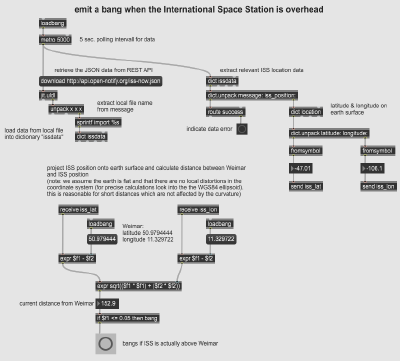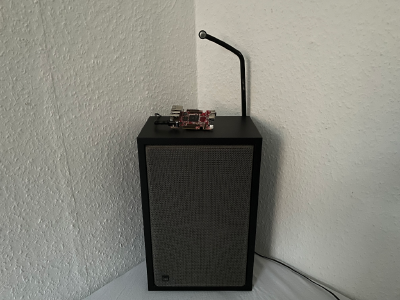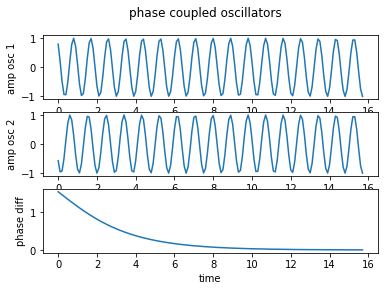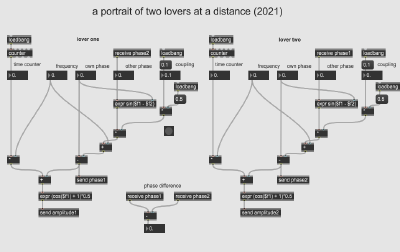This page documents my work and experiments done during the "Max and I, Max and Me" course. Feel free to copy, but give attribution where appropriate.
final project: ISS overhead
The International Space Station is currently the only extraterrestrial habitat for humans. It circles the earth approximately every 90 minutes and thus can look down on a vast planet. Humans on the other hand rarely look up and grasp what we accomplished and what we can reach for. This small installation tracks the International Space Station and emits a notification if it is above the place of exhibition. A handbell is rung and the names of the people currently in outer space are read out loud.
The technical setup consists of a computer running Max and some means of notification like a bell or a speaker. The current position of the International Space Station is calculated from its orbital data and set into relation to the place of exhibition (e.g. Weimar). If the ISS is at a place which can be considered overhead the notification is triggered.
implementation notes
The basic Max patch for tracking the ISS and sending a bang is done.

Processing TLE files and orbital data was sidestepped by relying on open-notify.org and processing JSON data. The distance (on earth) to the city center of Weimar (at 50.979444, 11.329722) calculated using the euclidian distance as a metric. To simplify the math it is assumed that the world is flat and the WGS 84 reference system is ignored. This is ok for small distances where the curvature of the earth does not result in too much of an error.
The Max patch was exported to a standalone application. It is now run on a small computer board to reduce the complexity of the setup. The data about the ISS crew is scraped from the internet using custom written software.
Lessons learned:
- sometimes you can find an API for exactly the data you need
- occasionally ignoring the material reality is feasible on very narrow bounds
- school math turned out to be useful
references
project: distance communication
Different implementations of the algorithm were tried in Max. None yielded a convergence of the phases of the oscillators. Therefore the project was cancelled.
The installation "distance communication" explores and reflects on (romantic) relationships at a time where partners are apart. Their lives don't take place in the same environment anymore and are open to different influences. It takes effort to stay in sync even though a distance may be bridged by modern communication means. Two blinking LEDs represent the partners, the blinking rhythm their respective lives.
The technical setup consists of two LEDs driven by a microcontroller and sensed via a light-dependent resistor. A small computer (laptop or small form factor PC) runs both Max and a video conference software to display "the other". The Max patch and the "other" are displayed on a screen or video projector. The Max patch tries to synchronize the respective blinking pattern by leveraging the well studied behaviour of fireflies. A microphone on the floor picks up ambient sound. If this audio level exceeds a given a threshold the blinking of one LEDs is triggers / reset to introduce disturbance in the process. The installation may be presented with both parts in the same room or one part off-site somewhere else.
implementation notes
The firefly model turned out to be insufficient for the current setup due to the small number of agents. The interaction has been remodeled from first principles based on two harmonic oscillators and the Kuramoto–Daido model for phase locking.
Observing the equation system over time shows the expected behavior (when implemented in Python).
Max implementation of the Kuramoto-Daido model
references
- Kuramoto, Yoshiki (1975). H. Araki (ed.). Lecture Notes in Physics, International Symposium on Mathematical Problems in Theoretical Physics. 39. Springer-Verlag, New York. p. 420.)
Buck, John. (1988). Synchronous Rhythmic Flashing of Fireflies. The Quarterly Review of Biology, September 1988, 265 - 286.Carlson, A.D. & Copeland, J. (1985). Flash Communication in Fireflies. The Quarterly Review of Biology, December 1985, 415 - 433.Lloyd, J. E. Studies on the flash communication system in Photinus fireflies 1966Nobuyoshi Ohba: Flash Communication Systems of Japanese Fireflies



